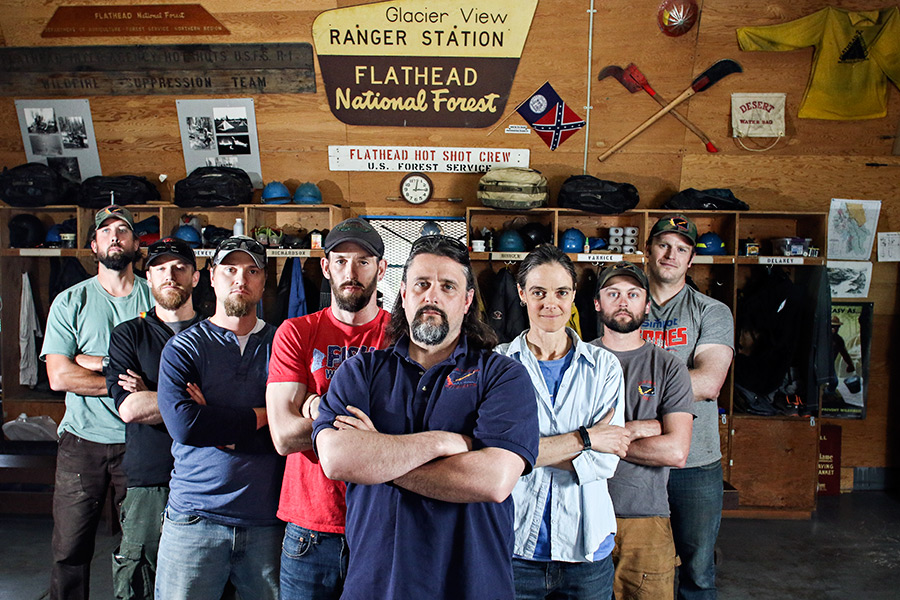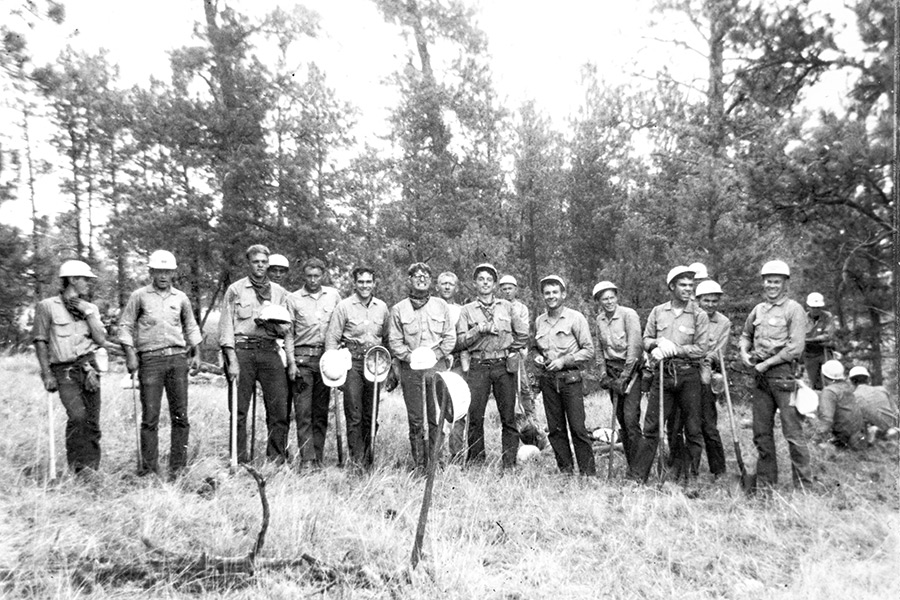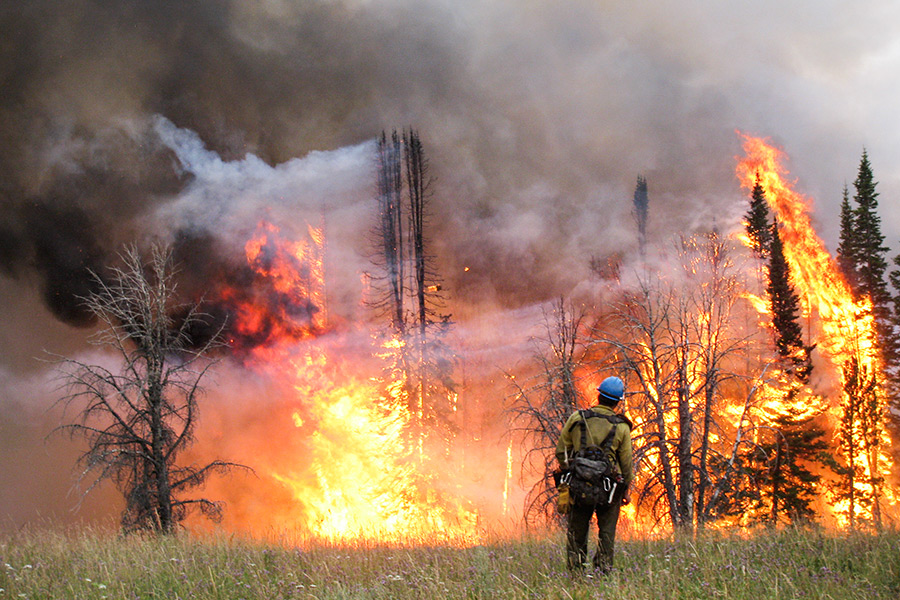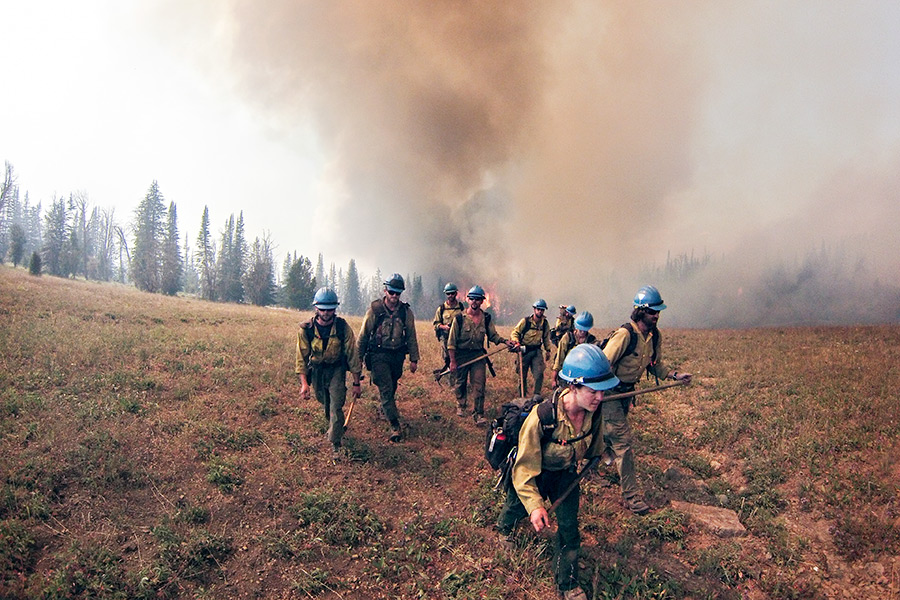The hotshot crew from Hungry Horse pressed into the deep forest as smoke cloaked the skies above central Idaho. The group of men and women, coated in dirt and sweat after several long days and nights entrenched in the Rocky Mountains, were hell-bent on corralling a 500-acre blaze chewing through the Sawtooth National Forest.
On this fateful day in August, the Flathead Hotshots were preparing to light a burnout when the radios echoed with a startling message. The team had assigned a person to serve as lookout. While hiking a steep, rocky ridge, the experienced crewmember dislodged a 200-pound boulder that pinned him against a rockslide. The boulder crushed his leg and sheared his femur.
Faced with a sudden emergency, the hotshots initiated a “rapid extraction process” and hustled up the mountain to find their injured colleague. Some members began cutting down trees and clearing brush to create an evacuation site for a helicopter while others treated the victim, removing the boulder and addressing the serious wound, which was bleeding heavily.
Within an hour, a helicopter arrived to transport the victim. But after landing, the aircraft tipped backward, breaking its internal fantail rotor, rendering it useless atop a high ridge.
Now, faced with a new emergency as an active fire burned around them, the local hotshots, with the help of other crews, safely moved the victim a few hundred yards uphill, secured the broken helicopter and began cutting another evacuation point. Within two hours, a National Guard helicopter responded and successfully hoisted the victim from the ridgeline and transported him to the hospital, where he was treated and cleared days later with his leg intact.
The remaining hotshots turned their attention to the broken-down helicopter, lassoing a line around several trees and pulling the large aircraft from the ridge before it tumbled downhill.
Overcoming the high-stress situation with calm efficiency six years ago garnered the local team national recognition and accolades.
Immediately after the incident, the crew resumed its regular routine: attacking the most volatile sections of large fires, regularly in 16-hour shifts, living, working and sleeping in dirt, ash and soot under punishing conditions in sweltering heat for 14 days at a time all summer.
“What I like about this crew is we suffer,” says Jim Dalen, a Whitefish native in his eighth year with the hotshots. “And on this crew, we laugh while suffering.”

THE FLATHEAD HOTSHOTS ARE AMONG the oldest and most respected crews in the nation, dating back 50 years this summer.
The country’s first hotshot teams were formed in Southern California in the late 1940s as a rugged, multi-skilled group that got its name for attacking the hottest parts of wildfires.
As firestorms increasingly emerged on the nation’s landscape, the U.S. Forest Service and other federal agencies formed the Interagency Hotshot Program and established nine national crews in the early 1960s, including the Lolo Hotshots south of Missoula. The Bitterroot and Nez Perce national forests formed two separate teams in 1962, and in 1966, the Nez Perce crew, called the Slate Creek IR Crew, was moved to the Flathead National Forest, where the hotshot team was based at the Big Creek Ranger Station up the North Fork.
The local crew worked out of Big Creek until 1982, when its duty station was moved to the Glacier View Ranger Station. In the fall of 1993, the team moved to the newly established compound at the Hungry Horse Ranger District, where it remains today.
In this era of violent wildfires burning larger and more often than anytime in the nation’s history, there are now 107 hotshot teams across the country. Yet fewer than 20 remain from the original era of the 1960s, such as the Flathead Hotshots.
“The fact that they have been in place and been as respected as they are as a crew for 50 years is a significant accomplishment,” says Steve Frye, a longtime wildland firefighter and Type I incident commander with the Montana Department of Natural Resources and Conservation in Kalispell.
“The Flathead Hotshots, and the Region One hotshot crews in general, are the standard against which I judge all other hotshot crews — their experience, the level of leadership, training and cohesiveness. They really embody the concept that the whole is greater than the sum of the parts.”
Frye added, “The Flathead Hotshots are a known commodity. They’re the best of the best.”
As another summer approaches, the local hotshots are preparing for six months of non-stop action. Even if this corner of Montana is quiet in terms of activity, the hotshots travel the continent chasing fire, from Canada to Alaska and anywhere in the U.S. On average, the Flathead Hotshots work 100 operational shifts a season with two days off every two weeks. An operational shift can run anywhere from eight to 16 hours without a break.
The number of large, catastrophic wildfires has increased dramatically in the last decade. Wildfires have consumed millions of acres of forest and destroyed hundreds of homes on an annual basis in recent years, and the number of wildfires larger than 1,000 acres has doubled across the West since the 1970s. Six of the worst fire seasons in terms of burned acreage have occurred since 2005.
In the heart of fire season, hotshots are among the most in-demand resources in America.
The 20-person crews boast a lean-and-mean reputation as an elite unit of men and women who can do it all. Outside of fire season, hotshots respond to natural disasters, such as hurricanes, and search and rescue operations.
They use every fire tool in the arsenal, from Pulaskis to chainsaws and drip torches, which are used for burnouts and backfires. Their ability to “fight fire with fire” distinguishes them as particularly unique and useful. Only a select few resources in the nation can carry out burnout operations. A burnout or backfire involves sparking a new fire that consumes the fuels in the path of an opposing blaze, creating a buffer. It effectively halts a cataract of flames in its tracks. It also can doom fire crews and create hundreds, if not thousands, of acres of trouble.
For this reason and many others, including the severity of the situations crews regularly find themselves in, hotshots undergo rigorous training. In the coming weeks, the team will embark on an 80-hour critical training program that includes classroom and field work. It will also involve serious physical training and “hell day,” an experience described as similar to the military’s boot camp.
“It’s all designed to push humans to the limit of their capability. But it’s not their capability that I’m interested in testing, it’s their will,” says Shawn Borgen, who first joined the Flathead Hotshots in 1996 and is in his second summer serving as superintendent of the crew.
“What I care about is the heart you put into the job. That’s what everybody respects.”

THE GRUELING REGIMEN THAT GOES into preparing for summer is not just a test; it’s a series of vital measures seeking to ensure survival.
Not only do hotshots take part in the most complex fire operations and situations, they also stand atop the food chain in terms of physical and mental requirements and self-sufficiency.
“We’ll hike whatever distance through broken terrain, then we’ll fight the fire and then we’ll cut and dig and fiend and bleed and sweat as long as that takes,” Borgen says.
Hotshot teams can survive alone in the wild for 72 hours, carrying 50-pound packs with minimal gear and shelter while eating military-style rations. They prefer sleeping in the woods instead of established fire camps. Many hotshots are former military, and the crew’s structure and relentless tactics are similar to the military and its chain of command.
“A lot of what I enjoyed in the military I enjoy in this job: The chance to do physical exertion, the chance to suffer and the chance to be in the woods, which is where misfits probably belong,” says Jeff Barker, who previously served in the military before joining the Flathead Hotshots three years ago.
A study in the late 1990s found that the average male hotshot will lose 15 percent of their bone density from the wear and tear of fire season. The average female hotshot can lose upwards of 23 percent.
Broken bones and injured joints are common; bumps, bruises, cuts and scrapes are guaranteed. In 2008, two Flathead crew members were struck by lightning on a fire.
For these reasons and others, hotshots stand out among all fire crews with a noticeable identity colored with bravado and ruggedness.
“I know for some people it is part of their identity. It follows you certainly. It has some street cred,” says Paul Linse, a former Flathead Hotshot and superintendent who is now the branch chief of aviation operations for the Forest Service.
Linse credits his training and experience as a Flathead Hotshot for helping him reach his position as the chief of all fire aviation resources in the nation.
Linse started as a sawyer for the Flathead Hotshots in 1979 and was there through 1996.
“It was fun to be part of an elite crew. You finally realize after a few years that you’re part of a special team,” he says.
“The camaraderie among the crew was always a big part of it. At the end of the year, it was kind of a letdown because everybody dispersed. You get to see a lot of places in the U.S., sleeping out on a ridge in the middle of the wilderness somewhere. That’s pretty special.”

THE FLATHEAD HOTSHOTS PREPARE for the season inside a brown Quonset hut in Hungry Horse near Glacier National Park. The base is brimming with tools, equipment and a weight room. Old sewing machines are operational in the loft for crewmembers to mend their pants and sleeping bags, among their many resourceful talents. The walls throughout the main bay are lined with black-and-white photos of former crews, dating back to the original group in 1966.
The team takes pride in its history and heritage. Seven members have been on the team for over 15 years. Turnover among the crew is rare and the average team member is 28 to 30 years old. On most other teams, the average member is in their mid 20s.
“There are many crews that started and were erased from history. The fact that this crew has been around 50 years is a huge deal,” says Justin Randall, a longtime firefighter and new foreman for the Flathead Hotshots.
“You want to honor those who came before you and you want to set the example for those who come after you. Just that in itself is a pretty major driving force. The physical pain and work that we all endure, that makes it worth it. You look back on our history, at those who came before you, and it drives you to continue to roll out of your sleeping bag on rocks in the morning and keep marching forward.”
The Flathead Hotshots have a unique identity beyond the age and experience.
A defining quality of most hotshots is a machine-like efficiency. This includes walking in straight lines anywhere and everywhere, including fire camp, with tucked in shirts and orderly attire.
Not the Flathead Hotshots.
“We take pride in not walking the line,” Borgen says. “I think there are disadvantages to walking in a line, personally. When you’re in a line, it’s easy to turn your brain off and fixate on the boots or the pack of the person in front of you. But when you’re not in a line, it forces you to look around and pay a lot more attention to your environment.
“We do not conform.”
As chief of the crew, Borgen leaves it up to his team to decide how they want to walk or whether they want to tuck in their shirts as a sign of respect and expectation.
“Allowing people to have a little bit more flexibility in terms of their personal choices gets better morale as the season wanes on and the years wane on. And when morale is better, health is better, physical condition is better and the product is better,” Borgen says.
“Our methodology is a little different, but when you hit the ground, our safety and our quality and our quantity of product is right there on par, if not above par, consistently. Every crew is the best crew, just ask them. I don’t really care about that, I just want to be consistently rad.”
The job certainly has its sacrifices beyond the mental and physical suffering. For members with families, it means going away for several months at a time before coming home.
Randall, the new foreman who previously served on other hotshot crews, had a hard decision to make before accepting the job in Hungry Horse. As a third generation wildland firefighter in Montana, he felt compelled and drawn to the career. But with two young children, he knew his new role with increased responsibility would create a significant burden for his wife.
“There’s a tremendous amount of sacrifice that goes into this job. I oftentimes realize at the end of the season, I’m beat down and tired and want it to be over but my family is even more beat down and tired than I am,” Randall says. “It gets harder every year. In the same sense, it’s another reason that I want to be here. I’m here because I enjoy and love and respect everybody on the crew and what we’re doing, and it provides me a great opportunity to provide my family with the best life I can.”
In many ways, the hotshots are a family. A natural bond develops when you spend countless hours and days on end together. Also, the experience of life-threatening and dangerous situations can bring people together.
“The relationships that they develop on the crew, sleeping in the dirt, working long hours, seeing things they probably have never seen before, stays with them forever,” Frye, the longtime fire commander, says.
“That extends beyond hotshot crews to the entire wildland fire community. It is very much like a large family.”
As this season has approached, the Flathead Hotshots have gathered old photos and information about their 50-year history. It has lead to proud discoveries of the old crews — “Those guys were hardcore,” Borgen says — and exciting anticipation for another season among the current crew.
Inside the hut in Hungry Horse, a family reunion is about to take place, followed by a wild adventure across the U.S.
“We’re all in this together from top to bottom,” Borgen says. “I’m very proud of this crew. I take a lot of pride in this crew. I love these guys.”
The Flathead Hotshots are holding a public celebration for its 50th anniversary and are inviting the community to visit their base at Hungry Horse Ranger District. The event is Friday, May 13, at 1 p.m. with the crew serving a free luncheon. An alumni celebration is scheduled for the following day. For more information, visit flatheadihcinfo.wix.com/flathead-hotshots.
